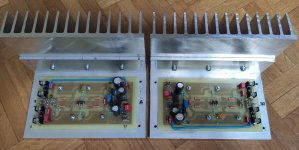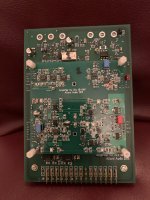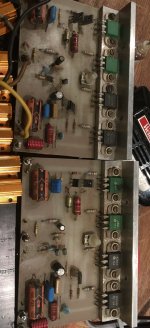Hi all,
I have been given an old, home made PA amp that was blown in one channel and dodgy in the other. It seems to be a lateral mosfet design, somewhat simpler than the hitachi data sheet design and not really capable of the power supply the chap had fitted.
I have junked then amp boards and am left with two 625VA 42vrms dual secondary transformers (the amp was dual mono) and 20,000uf of capacitance.
This translates to fail voltages of around +- 60v unloaded and around 52v at 10 amp load.
I have been casting around for a suitable power amplifier circuit to use this with. It seems that the voltage is too high for class A designs and so am looking at class AB.
I have read around the subject and cannot decide between mosfet or bjt based output stage amplifiers, it seems more down to the implementation than the underlying technology from what I have been able to gather but would welcome correction or comment on the same.
I of course have seen the Honeybadger sticky and a couple of Apex audio amps but would appreciate more suggestions to research too.
I have been given an old, home made PA amp that was blown in one channel and dodgy in the other. It seems to be a lateral mosfet design, somewhat simpler than the hitachi data sheet design and not really capable of the power supply the chap had fitted.
I have junked then amp boards and am left with two 625VA 42vrms dual secondary transformers (the amp was dual mono) and 20,000uf of capacitance.
This translates to fail voltages of around +- 60v unloaded and around 52v at 10 amp load.
I have been casting around for a suitable power amplifier circuit to use this with. It seems that the voltage is too high for class A designs and so am looking at class AB.
I have read around the subject and cannot decide between mosfet or bjt based output stage amplifiers, it seems more down to the implementation than the underlying technology from what I have been able to gather but would welcome correction or comment on the same.
I of course have seen the Honeybadger sticky and a couple of Apex audio amps but would appreciate more suggestions to research too.
There is probably no place on earth where you can find more amp designs as on this DIYaudio forum.
So take some time and look at as many alternatives as you like.
What I don’t understand is why your supply is supposed to be too high for class A.
My 100Watt@8Ohm class A amp has a +/-55V supply.
Hans
So take some time and look at as many alternatives as you like.
What I don’t understand is why your supply is supposed to be too high for class A.
My 100Watt@8Ohm class A amp has a +/-55V supply.
Hans
Well, quite. Too many perhaps! 😀There is probably no place on earth where you can find more amp designs as on this DIYaudio forum.
Hans
I started at the “threads of interest” sticky at the top of this forum but was wondering if there were any more designs that have been popular and perhaps a comment or two on those designs from those who have built them. I admit my question could have been phrased better. 🙂
I discounted class A on 60v rails on the basis of dissipation and heatsinking needed. Given that my ML-2s are only 25 watts and operate as reasonably efficient room heaters and are the size of a small subwoofer, I had worked out that a 100w class A would be huge. Hi the not something I have completely discounted but from reading the Pass forum and for a first build I thought to stick something a bit easier in terms of thermal engineering. I am open to suggestions though, can you tell me more about your amp?
Merci Jacques, I had seen that design and have spent a lot of time on his website.
It’s definitely one of the options. 🙂
Have you built or heard this design?
Member
Joined 2009
Paid Member
I sometimes get irritated when people keep plugging their favourite amplifier but since you asked here's my recommendation - it's my design, arrived at after many years of playing around in this hobby. It was designed for 50V rails but like most amplifiers, with proper consideration of parts choices it could be stretched up to higher voltages.
TGM8 - an amplifier based on Rod Elliot P3a
Otherwise, unless you are interested in building you own amplifier I'd suggest instead that you look at a good quality, ready-built modules, from eBay. This could get you back up and running quite nicely and these days. I don't have a specific module to recommend based on my own experience I'm afraid but leave that as a thought. And I would suggest looking at class D too since the technology has really come along way.
TGM8 - an amplifier based on Rod Elliot P3a
Otherwise, unless you are interested in building you own amplifier I'd suggest instead that you look at a good quality, ready-built modules, from eBay. This could get you back up and running quite nicely and these days. I don't have a specific module to recommend based on my own experience I'm afraid but leave that as a thought. And I would suggest looking at class D too since the technology has really come along way.
Plug away, this is exactly the sort of thing I was after. 🙂
It’s going to take some time to read that thread but as I say, exactly the sort of thing I was hoping for.
I want to solder this one, I have built a set of active 3 ways from a friend’s ancient set of Bolivar Speakerworks Model 64 that involved ready made amplifier modules and it was fun and worked very well.
I’ve always fancied a crack at building an amp from scratch but haven’t the experience or electronics yet to tackle my own design.
Hell, I’m now thinking about 100w class A as well now...😀
It’s going to take some time to read that thread but as I say, exactly the sort of thing I was hoping for.
I want to solder this one, I have built a set of active 3 ways from a friend’s ancient set of Bolivar Speakerworks Model 64 that involved ready made amplifier modules and it was fun and worked very well.
I’ve always fancied a crack at building an amp from scratch but haven’t the experience or electronics yet to tackle my own design.
Hell, I’m now thinking about 100w class A as well now...😀
Last edited:
There is probably no place on earth where you can find more amp designs as on this DIYaudio forum.
So take some time and look at as many alternatives as you like.
What I don’t understand is why your supply is supposed to be too high for class A.
My 100Watt@8Ohm class A amp has a +/-55V supply.
Hans
Have you posted up your schematic Hans?
It’s definitely one of the options. 🙂
Have you built or heard this design?
Hi Lord,
I built them as a challenge after completing Elliott's P3As and wanting to hear lateral mosfets.
The P101s sounded pretty good to my old ears but never made it to a finished chassis...
Cheers,
Jacques
Attachments
Have you posted up your schematic Hans?
Hi Andrew,
No I haven’t.
I started with two ML20.6 monoblocks.
Threw away the outdated amplifier boards, designed a whole new two stage setup, the first stage a 27dB amplifier followed by a 0dB current amplifier in a nested feedback topology, still using the original MJE15030/15031 pre drivers and MJ15024/15025 drivers. It was a swop of the socketed amp board by a completely redesigned one populated with modern SMD components.
It must be seen as a technological challenge but not as a DIY project because you will need a ML20.6 for the power supply etc.
Here is a picture of the board.
Hans
Attachments
The ML20 has 24mF caps after the rectifiers, this 80V goes into a 55V regulated supply for the whole amp including the drivers.
The regulated supply has 9mF caps.
Transformers are probably 1Kwatt.
Hans
The regulated supply has 9mF caps.
Transformers are probably 1Kwatt.
Hans
What number and how many lateral mosfets were used in the original design? Show us a pic of your chassis.
I can suggest the Dh-220c design as an option.
I can suggest the Dh-220c design as an option.
Bi polar has the advantage of being able to reach close to the rails.
Mosfets tend to only get to within a few volts of the rails.
The output mosfets usually dont take as much driving as bipolar as the gates are capacitive rather than taking a lot of current like bipolar.
Mosfets tend to only get to within a few volts of the rails.
The output mosfets usually dont take as much driving as bipolar as the gates are capacitive rather than taking a lot of current like bipolar.
Hi Lord,
I built them as a challenge after completing Elliott's P3As and wanting to hear lateral mosfets.
The P101s sounded pretty good to my old ears but never made it to a finished chassis...
Cheers,
Jacques
Very cool Jacques, I like your approach of building a few different designs and comparing. If one has the power supply the rest is pretty cheap to chop and change. 🙂
What number and how many lateral mosfets were used in the original design? Show us a pic of your chassis.
I can suggest the Dh-220c design as an option.
J82 and k226, if there was a reliable source I would think about resurrecting them. As you can see the board on the right blew up quite spectacularly. 😀
Thanks for the name of the design, I had not come across it before and will look it up.
Thanks for the pics and info. How big are the heatsinks?
I do not know of a reliable source for those old Hitachi mosfets, but they are in a unique package that is long obsolete, so making fakes might not be as easy as a common package.
One usually states their budget for a new build since that may determine what choices are available. For example a lateral mosfet design is much more expense compared to a bjt type output stage.
I do not know of a reliable source for those old Hitachi mosfets, but they are in a unique package that is long obsolete, so making fakes might not be as easy as a common package.
One usually states their budget for a new build since that may determine what choices are available. For example a lateral mosfet design is much more expense compared to a bjt type output stage.
J82 and k226, if there was a reliable source I would think about resurrecting them. As you can see the board on the right blew up quite spectacularly. 😀
These lateral mosfets can be replaced by 2SJ182 & 2SK1058 or ECX10P20 & ECX10N20.
- Home
- Amplifiers
- Solid State
- Suggest an amplifier for my power supply


